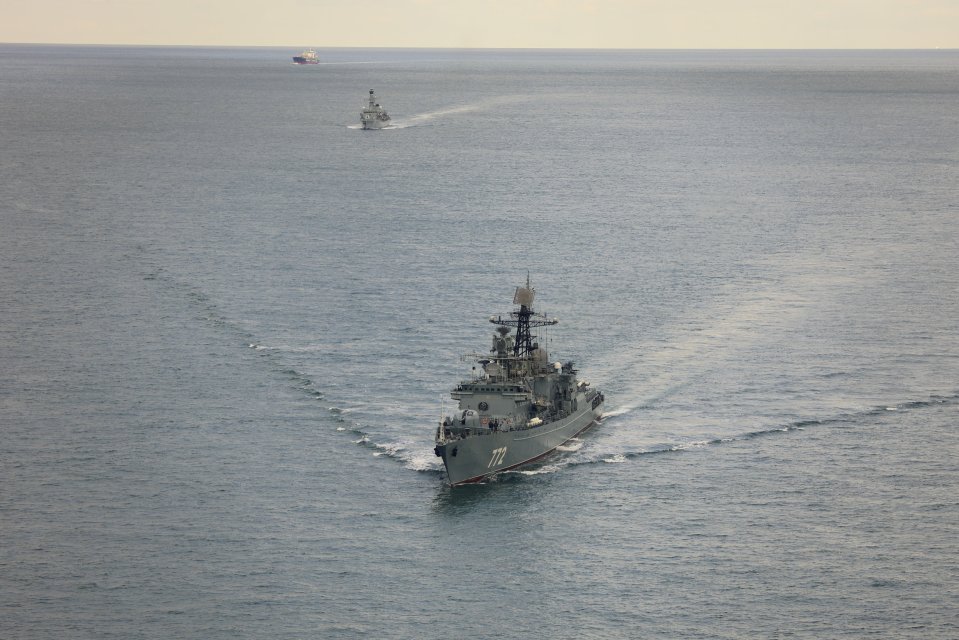ROYAL Navy was forced to dispatch HMS Iron Duke after a Russian warship entered British waters amid rising tensions between Moscow and Nato countries.
The crew aboard the HMS Iron Duke, supported by a Wildcat helicopter, tracked RFN Neustrashimy as it escorted Russian freighter Sparta IV through the North Sea and the English Channel.
SWNSHMS Iron Duke shadows RFN Neustrashimy and cargo ship Sparta[/caption]
SWNSIt marks the 18th time a Type 23 frigate was activated to monitor 25 Russian vessels in the past 12 months[/caption]
SWNSPlymouth-based HMS Iron Duke was dispatched for the three-day operation[/caption]
It marks the 18th time a Type 23 frigate was activated to monitor 25 Russian vessels in the past 12 months.
The Royal Navy issued a stark warning that Moscow is sending a rising number of vessels through British waters.
It all comes after a series of suspected Russian incursions into Nato airspace.
Defence Minister Luke Pollard said: “Russian warships are increasingly transiting through the English Channel,” Defence Minister Luke Pollard said.
“The Royal Navy protects the UK 24/7 to monitor Russian movements, ensuring the security of our waters and undersea cables.
“Alongside our commitment to NATO’s Eastern Sentry, this is a clear demonstration of how the UK stands firm with our Nato allies to deter Russian aggression.”
The Wildcat, from Yeovilton’s 815 Naval Air Squadron in Somerset, joined Plymouth-based HMS Iron Duke for the three-day operation.
Another Nato force began monitoring Sparta IV near the French island of Ushant, off Brittany, as it continued towards the Mediterranean, Royal Navy said.
It continued to watch RFN Neustrashimy as it sailed back through the English Channel and the North Sea towards the Baltic, and the mission ended on Tuesday.
Commander David Armstrong said: “This type of tasking goes largely unseen, and as a ship’s company we are extremely proud of our direct contribution to the UK’s national interests, more specifically to the security of our energy, data, food and trade and to the country’s critical national infrastructure.
“It is important as an island nation to steadfastly safeguard the security of our seas.
“The Royal Navy is focused and fully committed to the extremely busy military aspects of the broader maritime security mission.”
Meanwhile, The North American Aerospace Defense Command (NORAD) said it detected two Russian Tu-95s, which are long-range strategic bombers, and two Su-35s, advanced fighter jets, operating in the Alaskan Air Defence Identification Zone (ADIZ).
NORAD said it responded with an E-3, four F-16s and four KC-135 tankers “to positively identify and intercept in the Alaskan ADIZ.”
Security concerns in Europe are at a heightened state following an increase in Russian sabotage activities and multiple drone and fighter jet incursions into Nato airspace in recent weeks.
Poland downed drones that violated its airspace on September 10 as Russia launched a wave of aerial attacks on Ukraine.
It prompted a dramatic million-dollar response from Nato as fighter jets were scrambled and Patriot air defence systems placed on alert.
It marked the first time since Russia‘s invasion of Ukraine in 2022 that Nato has directly engaged with Russian forces.
A Russian MIG-31 fighter jet flying above the Baltic sea
And it was followed by a Russian drone overflying Romania for 50 minutes on Saturday.
Russian pilots later staged a 12-minute incursion into Nato airspace.
Three Russian MiG-31 fighter jets entered Estonia’s airspace “without clearance” – triggering an emergency Nato meeting.
The fighter jets reportedly flew over Vaindloo Island and stayed there for nearly 12 minutes.
Shortly afterwards, Polish authorities reported a “low flyover” of Russian military planes near an oil and gas platform.
Donald Trump responded to the reckless violation and said the incursion could cause “big trouble”.
Meanwhile, Danish police are investigating the appearance of drones over Copenhagen Airport on Monday night.
Denmark‘s intelligence agency said the country faces “high threat of sabotage” after the drone sightings.
Ukrainian President Zelensky claimed Moscow was behind it, referencing “Russia‘s violation” of Nato airspace in Copenhagen in a social media post.
Kremlin spokesman Dmitry Peskov described any allegations linking them to Russia as “unfounded”.
Footage showed a drone flying close to the Copenhagen airport on Monday
X/@MSchieller69609Drones flew over multiple airports across Denmark and caused one of them to close for hours[/caption]
Last weekend, Heathrow, Brussels and Berlin airports were all thrown into turmoil after a massive cyberattack.
Airlines were forced to fall back on paper-based workarounds to get travellers boarded.
The EU’s cybersecurity agency confirmed malicious software was used to lock airport systems, saying: “The type of ransomware has been identified. Law enforcement is involved to investigate.”
Intelligence experts believe this latest wave of chaos bears all the hallmarks of a state-backed hit job.
Security and politics expert Anthony Glees told The Sun: “Without doubt, the Russians are behind these attacks on airports in London, Berlin and Brussels.
“No one can doubt that Putin’s strategic planners are the beneficiaries here because they have been able to demonstrate they can attack our cyberspace with impunity and at will.”
Travellers wait at Brussels airport after a cyberattack disrupted operations over the weekend

